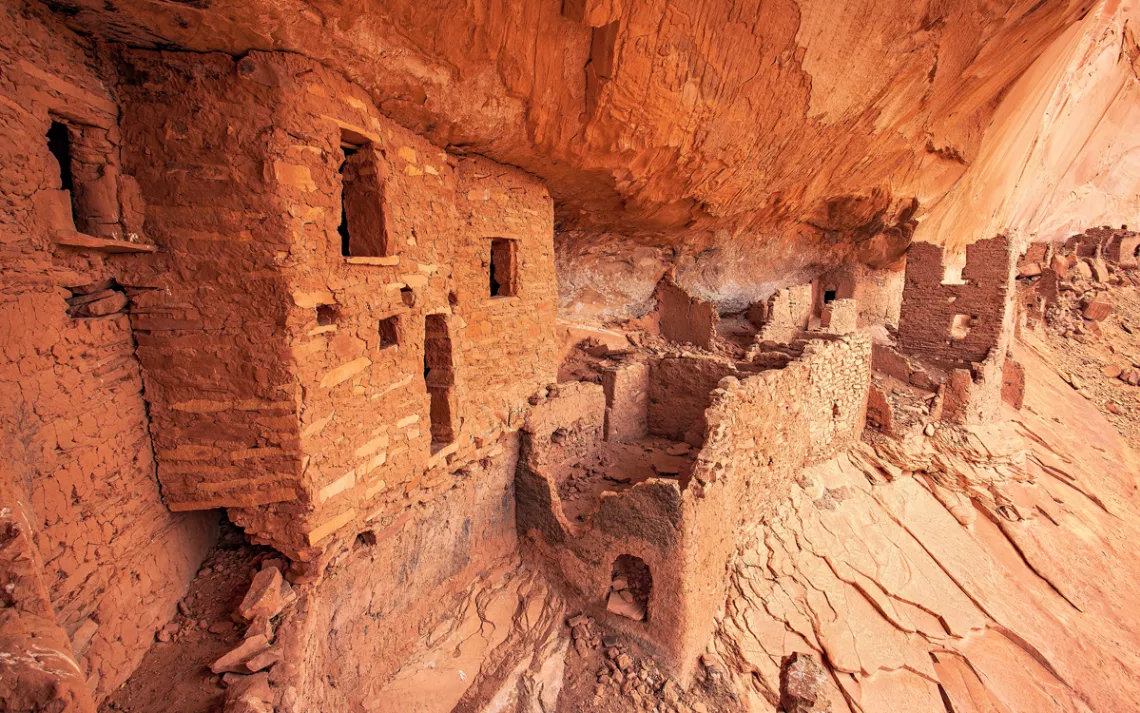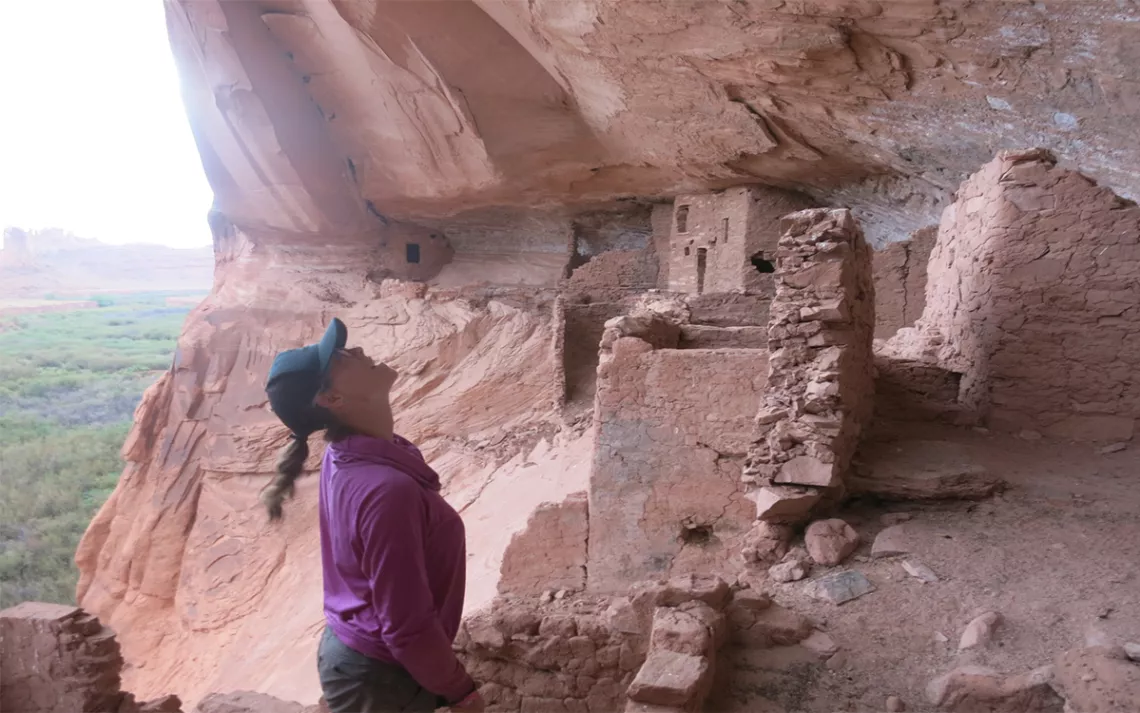Fighting Cancer, An Adventurer Revisits Ruins of Ancient Civilization
David Roberts reconnects with the ruins of an ancient civilization

Photo by Grant Collier
THERE IT STRETCHED, only 200 yards away, filling the inward bend of the cliff that curled over it like an apocalyptic wave of sandstone. We would be there in half an hour, as soon as we crossed the Chinle. . . . But when I broke out of the tamarisk jungle and stood on the edge of the arroyo bank above the stream, I had to tell my companions, “It doesn’t go. Not here, at least.”
The floods of spring and summer had carved the channel of Chinle Wash into a chasm of petrified mud. The bank plunged 15 feet dead vertical. As the rim crumbled underfoot, I lurched back into the bushes.
For the next two hours, the four of us branched out in three chaotic search parties, losing track of each other. Exhausted, I threw my daypack to the ground and crawled into a hollow under the tangled branches.
“This isn’t the right way,” I told Sharon, my wife, who joined me in the green sanctum.
Twenty minutes went by. I felt hopeless, vulnerable, even a bit afraid—as I had not since, as a child in Colorado, I’d wandered to the edge of a forest in which I knew I would get lost and never come out.
“Emmett!” I yelled. “Sarah! Where are you?”

THREE MONTHS EARLIER, we were sitting at the kitchen table at my home in Massachusetts when I sang the praises of Cedar Mesa.
"It's the finest place in the country," I told Sarah and Emmett, “for unrestored ruins and little-known rock art panels.”
Fit athletes in their late 30s, Emmett and Sarah had discovered rock climbing a few years back. Now they were almost as fanatic as I had been in my early 20s, when I lived for unclimbed mountains in Alaska.
"But there's a ruin on the Navajo reservation—not many people know about it." Was that a glimmer of curiosity in their eyes? "I've been there three or four times, going back more than 20 years. But now I'll never see it again."

"Why not?" Emmett asked.
I tasted annoyance—he knew why not. Two years before, at the age of 72, I had learned that I had stage 4 throat cancer. Months of radiation and chemo had followed, and many days in the hospital. Twice I came close to dying. Back home, for weeks I could barely walk a neighborhood block. Then, just as I regained a small portion of my former strength, the doctors found that the cancer had metastasized to my lungs. Now an experimental immunotherapy was all that was keeping me alive.
“You know why,” I scolded Emmett. “I can’t backpack anymore. Four miles of easy hiking are about my limit.”
"We'll carry all your stuff."
I laughed. "I couldn't do that. Nobody has ever—"
"Why not?" Sarah echoed. "You've earned it, with all you've been through."
I couldn't, I repeated to myself. But slowly the notion took hold. Maybe I could.

THE OLD ONES. The Anasazi. Ancestral Puebloans. Hisatsinom. Whatever we call those prehistoric geniuses who built in shaped stone and mud, who painted their pots with yucca quills, who etched their myths into the canyon walls, when they abandoned the Colorado Plateau en masse around A.D. 1290, they left behind the vestiges of a civilization attuned to a cosmos we have never known. The archaeologists can explicate only one side of that lost culture. Those of us who set off down remote canyons in Utah, Arizona, and New Mexico glimpse another side. For the last 25 years, even as I traveled all over the world, I had found no form of exploration more compelling than the search for the Old Ones’ ruins and rock art.
Last September, four of us, including Sharon, set out on a barren plateau toward an escarpment that stretched across the horizon, beyond the Chinle Wash. Emmett and Sarah carried all the camping gear, leaving Sharon and me with just 15-pound daypacks. Because the only spring anywhere near the ruin might have dried up in the 10 years since I had last been there, Emmett carried eight gallons of water as well—64 pounds of life-sustaining H2O.
Now, four hours into our hike, hunkered under the tamarisk, I heard Emmett’s distant cry. “Over here! I found a crossing!” We rendezvoused on the bank farther west. Emmett had managed to hang from roots and lower himself off the vertical mud cliff, split his monstrous pack into pieces, wade the quicksand slurry up the Chinle, then gouge hand- and footholds in the bank with a stout branch, like an ice climber with his axe, to carve a passage.

Map by Steve Stankiewicz
Forty minutes later, we flung down our packs by a spring, which I imagined flowed as clear and steady as it had centuries ago. I sat on the bedrock where I had laid out my sleeping bag on a solitary journey 10 years before, and then I wept.
We pitched our tents, then lay on inflated mattresses as dusk turned to night. Cygnus and Lyra wheeled into view over the rim of Comb Ridge. A pair of meteors blazed toward nowhere and died.
Later I dreamed that I was backpacking into the Alaska Range with a partner who never spoke. Somewhere ahead, among the glaciers, the granite spires that hid the meaning of our lives thrust into the sky.

AS WE STEPPED carefully through the mortared rooms, I thought, Everything the Anasazi believed in is here.
"This is a crazy place to put your village. Here all the rooms are built on top of boulders. Over there"—I pointed north—"the floor is a 45-degree slab. They had to fill the foundations with dirt to make it level." I felt like a fussy professor, trying to explain the inexplicable. But Sarah and Emmett had never seen a Puebloan ruin before, and they seemed to hang on my words.
We moved from room to room. "There are five kivas here," I went on. "And 70 rooms. “One of them is the room where the Harvard team found the mosaic-encrusted knife. And T-shaped doorways. Nobody knows what they’re about.” Behind the rooms, the arching wall of the alcove blazed with pictographs in seven colors—triangle-bodied humanoids, spirals and snakes, headless blobs.
Sarah found many decorated potsherds, each of which she left in its place. After an hour passed, we stopped talking and sat on the bedrock between crumbling walls. A pair of ravens circled overhead. The silence says it best, I mused. Whatever their dreams meant to them, we. . . . I could not finish the thought.
“What about those upper rooms,” Emmett said at last, pointing at a row of structures 60 feet above the ruins, on a ledge in a smaller alcove guarded by a blank 70-degree cliff.
“I don’t know of anybody who’s been up there.”
“So how did they—?”
“You tell me.”
LATE THAT AFTERNOON, back in camp, we watched dark cumulus clouds race in from the west, then scrambled for our tents as the sky disgorged daggers of lightning. Alas, we had brought only one rain fly for our two nylon shelters. Now we piled all four into Emmett and Sarah’s tent and spread our mattresses wall-to-wall. It was fun at first, all snuggled together like kids in a treehouse, hiding out from the rain. But then I started shivering and couldn’t stop.
Sharon helped me into my sleeping bag, then hugged me. “It’s all right,” she murmured. “You just got chilled.” But the shivering grew worse, and my hands and feet started spasming in manic semaphors. All four of us remembered what had happened only three months earlier, in our rented condo in California, where we had gathered for my first climbing trip since cancer had arrived. There the sequence had been 911, then ambulance, then ICU, and only the antibiotics the doctors sent surging into my veins kept me alive.
We had a sat phone. Sharon had insisted on it, even though I cursed it as a crutch. In all my climbing years, I had never had to be rescued. But now we imagined the scenario—the frantic call, a helicopter in the night . . . or the next morning, too late?
Sarah covered me with her own sleeping bag. I lay in her embrace, cocooned in down. At last my body trembled to a stasis. Then came sleep—though in the groggy night I heard breathing all around me and reveled in the safety it portended.
In the morning, as I finished my coffee, I watched Emmett and Sarah load their packs. They still looked monstrous, even minus most of our food and some 55 of the 64 pounds of water Emmett had lugged across the Chinle. I felt a sharp pang of envy for their youth and fitness, but in the same moment, a flood of gratitude.
What could I ever do to repay their gift of love?
This article appeared in the September/October 2018 edition with the headline "In Ruins."
WHERE Chinle Wash, Navajo Nation
PERMITS To hike or camp anywhere on the Navajo Nation, you need a permit. Certain areas are off-limits to nontribal members. See bit.ly/chinle.
ETIQUETTE When visiting any Ancestral Puebloan site, please observe the following guidelines:
Do not stand or lean on the walls or roofs of granaries or habitation units. Don't climb or crawl through doorways or windows to enter the interiors of rooms.
Do not touch the rock art (human oils can degrade fragile pictographs and petroglyphs).
Do not remove any artifacts, even the tiniest potsherd or lithic flake. Don't arrange shards or flakes in collections known as "display rocks" or "goody piles." Leave them where you found them.
Do not publicly disclose the location of sites, especially with GPS coordinates. (Note that sometimes published photographs automatically import your camera's GPS metadata.)
Don't walk on or across a ruin's midden, the rubble pile directly below the site.
Don't build cairns to mark routes in the backcountry.
 The Magazine of The Sierra Club
The Magazine of The Sierra Club



